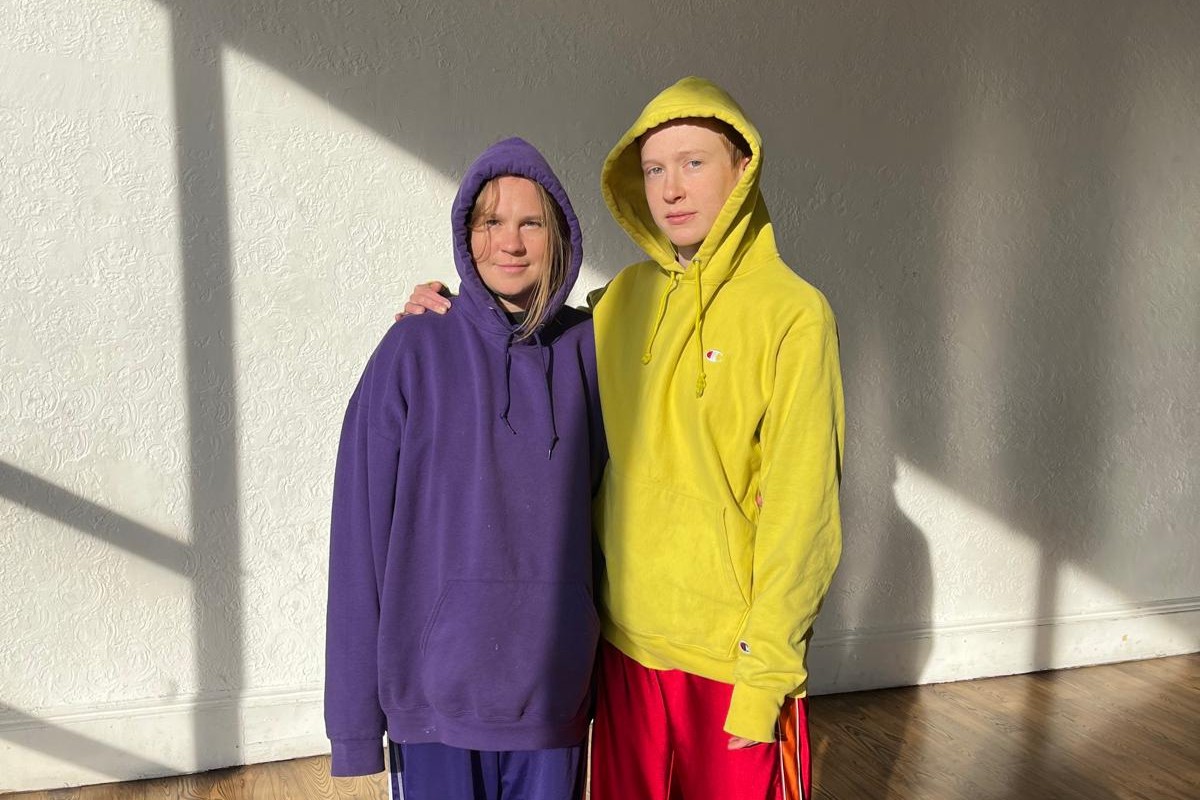interview by Hana Polanská
This is an open-ended conversation with American artists and dance theorists Nora Thompson and Chloë Engel, recorded during the Dancetopia 2025 festival in the forest setting of Kounice. The gathering created a space and time for sharing reflections on rethinking our relationship to dance, landscape, and one another. On the very first evening, we read my text together by the fire — a contextual piece introducing this year’s Dancetopia theme through the lens of a critique of the neoliberal logic of performance and growth, as it manifests in the bodies of artists and extends to questions of ecological and social justice.
We further discussed how the climate crisis cannot be separated from issues of marginalization, inequality, and exhaustion. The conversation with Nora and Chloë continues and expands on these ideas, touching on the unknown, madness, spirituality, apocalypse, and grief. References to madness and the unknown strongly resonate with the influential French journalist and writer Claire Touzard, who, in her politically charged autobiographical analysis Folie et résistance, argues that symptoms such as anxiety, depression, and burnout are not individual disorders but consequences of the neoliberal system. She proposes to understand “madness” as a form of political resistance. Both women also respond in the interview to an email I sent, in which I wrote that we are being asked to be happy in a world that wasn’t made for us. The call for happiness and resilience may serve as a silencing tool that masks structural violence. The interview articulates one of the most important current trajectories of experimental dance: a trajectory that sees dance not as a product, technical performance, or an aesthetic in service of dominant ideology, but as a way of relating — to others and oneself — as a particular kind of knowledge. It opens questions that feel urgent not only for dance but for our time more broadly. I believe this conversation with Nora and Chloë will intellectually enrich the Czech dance scene, as it manages to critically grasp and name the complex phenomena of our time through reflections on dance and art, while also acknowledging the limits of such critique and the danger of critical stereotypes we are exposed to when attempting it.
Nora Raine Thompson and Chloë Engel are contemporary dancers and performers based in New York, whose work moves at the intersection of choreography, writing, research, and activism. Both explore the body as a medium of knowledge, memory, and resistance, integrating artistic practice with academic and therapeutic contexts.
Nora Raine Thompson is a choreographer, performer, and researcher currently pursuing a PhD in Performance Studies at NYU Tisch School of the Arts, studying under André Lepecki. She graduated from Wesleyan University, and her work has been presented at venues such as Danspace Project, Abrons Arts Center, and Movement Research at Judson Church. Her artistic practice often builds on the concept of “unperformable tasks” and explores the limits of physical expression, wear, decay, and transience. In projects like Everything and Nothing or Rocks, she deconstructs narrative constructions of the self, working with materials like stone, water, and mist, and engages bodily presence as a form of political gesture. In addition to performances, she publishes essays on dance and performance in journals such as Movement Research Performance Journal, The Brooklyn Rail, and Danspace Project Journal.
Chloë Engel is a performer, improviser, and therapist working with young children. She studied at Bennington College (Performance) and, in her artistic practice, combines physicality with themes of madness, mental health, care, and queer existence. Her work is deeply influenced by her experience with “mad identity” — neurodivergent perception and movement at the margins of normativity. In performances such as Rubber, Device Not Detected, or Fleeting Glimpse, she works with a mutable, often fragmented body, text, play, and sound. She also creates interactive installations (The Space is a Body and You Are In It) and collaborates with artist Anna Kroll on projects like re:semblance. Her work fluctuates between study, play, and political imagination, connecting embodied research with therapy, care, and community-based sharing.
The two artists mutually influence and inspire one another. Their work shares a deep interest in the relationship between body, language, and social structures — whether through academic research, solo choreography, or through children’s imagination and the unconscious. In their creations, they move between the personal and the collective, between vulnerability and analytical distance, between intuition and structure:
Nora: We both have a background of ballet.
After a childhood in ballet, I attended university and learned about many other dance forms. Learned a lot of dance history and got really into improvisation and improvisational forms. And that’s also where the Judson scene started influencing me. And how that informs my theory now is that… my pattern with dance is falling in love with it and also feeling complicated about it, critical of it. And that definitely happened with learning about Judson and that movement and how those people talk about improvisation and both, feeling the ideals of it, of the potential for authenticity, the potential for freedom, but also feeling those false promises or promises that can be wrapped up in Western Euro-American ideals of neutrality – that those promises are only possible for certain people. I felt aware of being one of those people and wanted to dig into that more to make sure that I was not slipping into what can feel like a simplistically beautiful and open world of improvisation and experimental dance. And so that continues to be a theme of how I interact with dance both as a dancer and a choreographer, and now also as a writer and in the academic world. I want to keep unpacking and digging into what assumptions we’re making, especially about the practices that feel really good and feel liberatory and continuing to question that.
Chloe: I’m just thinking of it as frameworks and where am I arriving at this moment. And we grew up dancing ballet together, and then I went to school and had a choreographic explosion or something. I felt like I was able to understand how to research through doing. And also began writing a lot. I read The Feel Trio by Fred Moten and was highly influenced by his rhythmic and precise style of associative dumping. I began making work using this kind of associative spilling and then deriving movement from that. A lot of my personal research is about madness as a magical realm of understanding that has the potential to initiate interactions with that which can’t be seen or with dissolving the space between self and other. And then this other relationship to madness, a mental state that’s psychiatrized, pathologized, separated from society. Madness came up during Dancetopia in the fire conversation. This idea of what ideas are we limiting society from through this isolationist, carceral logic. And now I feel my research includes also the madnesses that I really have trouble understanding. Maybe some of these madnesses I have a sense of empathy for, I have a deep family lineage of madness and it’s quite close to the surface for me. And dance feels very much a way of exercising my own relationship to my own madness, I think. But I’m also quite curious about what I don’t understand. Like I don’t understand the instinct to hoard wealth. … I look to Elon Musk and Jeff Bezos and these oligarchs of our time, and I’m like: this is another kind of madness. Recently my research has been a lot about this. And a lot about dissolving that self and that other too. I want to understand that by understanding it within myself.
Nora: If we’re already talking about finding ways to notice or accept that we are not as separate as dominant Western forces might say we are, that means that we are more connected to Elon Musk than might feel comfortable. And we have to attend to that in ourselves.
Hana: And what is your research about?
Nora: I am framing my research with this idea of impossible tasks.
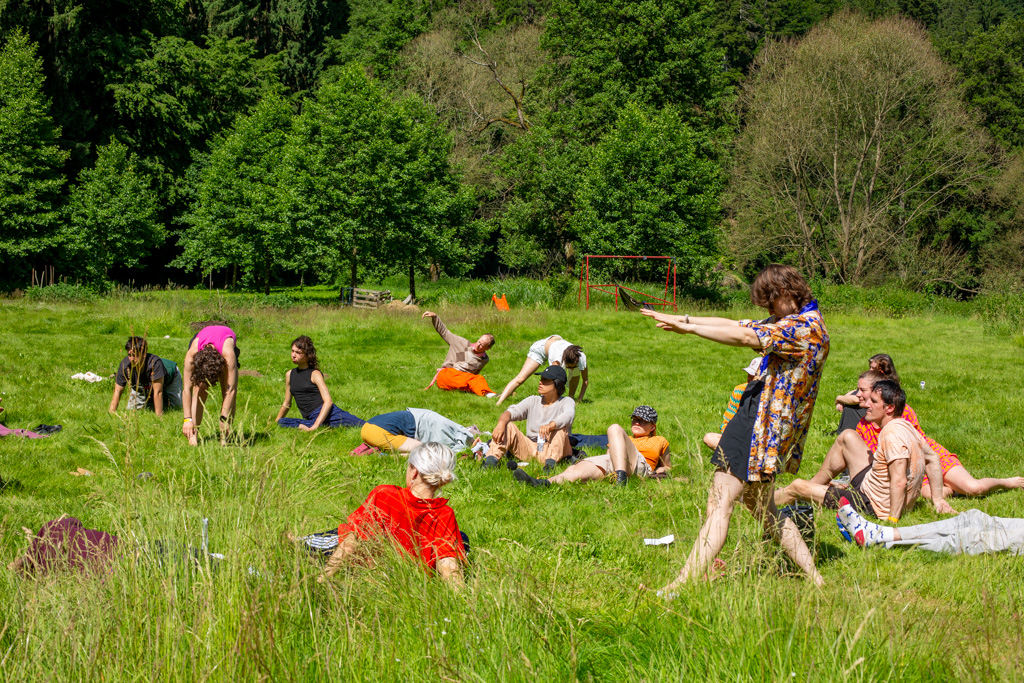
Hana: Not so far from madness.
Nora: Not so far. We (Chloë and I) influence each other a lot. We work together a lot, we are friends. But I came to “impossible tasks” because I was engaged in dances where I felt choreographers or teachers were asking me to do things that were impossible. In some ways I felt really grateful for that or interested in that. I worked with Eiko Otake for a long time and she has a lineage in Butoh and a lot of her prompts are as simple and absurd as “be marshmallow,” or “be flower.” And I’m like, impossible. But I’m interested. And I’m interested in trying. And then I worked with a choreographer named Nacera Balaza, who’s based in France and she’s French Algerian, who was posing tasks that felt more complicated and frustrating to me. Like, “be empty” or “become sound,” she would say, “be real, be authentic, stop performing”. And with these tasks I thought, wait, actually, I don’t know if that’s possible, especially if we’re going to be on stage. And wrestling with those questions led me to want to do more research into why and how these patterns of impossibility are happening in dance. And increasingly I’m feeling there’s some impossibles that are ideals – trying to turn the dancer into an empty vessel or a neutral zone or even an optimized virtuosic self, which feels related to certain types of madnesses of capitalism and of neoliberalism that insists on the possibility that you can be the most productive balanced bio-hacked version of yourself. So, there’s that realm of impossible. And then there’s also a realm that is maybe trying to just get us to realize what is already happening, what is already possible. These are things that might sound impossible in a framework of Western individualism. Like: I can feel what you’re feeling, Or I can hear your thoughts – if we go to the telepathy place which is something that Chloe’s researching. That, a sense that we can feel or listen across boundaries, might be deemed impossible by Western colonial entities but also has been actually named as possible and realistic by many indigenous communities and cosmologies, as well as people who are experiencing what Western colonial systems would call madness. And I think many dancers are interested in accessing those types of states through bodily research and collaborative research. I’m interested in how these two notions of impossible clash too, and how they’re sometimes using the same mechanisms. And where they’re blurry too.
Hana: That’s interesting, because it reminds me of a recent experience of mine, and I find it exciting to observe how the current cultural climate is reflected in experimental art. Last year, I worked with the well-known French choreographer Alice Chauchat, who lives in Berlin, and she also gave us tasks to dance impossible things, not to optimize us, but rather for the second reason you mentioned. She did it because she wanted to touch the unknown — for example, we were asked to dance a telepathic dance, or in her view, dance was a companion. As a dancer, I didn’t know what I was touching in her proposals, because she wasn’t suggesting something familiar to me, and something uncertain, unknown, and elusive began to emerge. It wasn’t possible to rely solely on knowledge of technique, style, or routine — or even on experience itself. And for me, it was incredibly inspiring to accept that uncertainty, that possibility of “not knowing.”
Nora: Yeah, and that’s what feels really exciting about doing these impossible tasks or why I’m interested in thinking about them more. Because you have to figure out a way to attempt it. And that’ll be personal. Or that’ll be in relation to the ways that you are different from other people. In relation to your personal history and your body and your body’s specific capacities.
Hana: Do you mean the body as an archive? André Lepecki writes about the body as an archive in the sense that it carries memory and knowledge through movement and embodiment — as a living, dynamic bearer of choreographic and cultural experience. Mårten Spångberg also writes about this idea, suggesting that dance is not a means of representation but a mode of knowledge production, with the body storing and transmitting experience through practice, affect, and temporally extended action.
Nora: Sure. And what I felt really aware of with this choreographer Nacera Belaza was the question of, what does it mean for me in my white female body to try to be empty – as opposed to someone else in the cast who has a really different body and experience and will be perceived really differently on stage. So, there are many questions.
Chloe: I am thinking as we are talking about perceiving the unknown. I think there’s something in the desire to rationalize. Maybe it reveals a hierarchy of knowledge. This naming, codifying, and categorizing as an approach to understanding which science performs, medicine performs, as well as lots of different western Euroamerican thought. To understand something, we must be able to name it. And I think dance and performance have a powerful proposition to not understand but to know.
Hana: How do you explain the fact that virtuosity, narrative, representation, technique, and traditional dance forms — often associated with modernism and its subsequent currents in contemporary dance — are increasingly being abandoned today? This shift is not merely a continuation of the opposing tendencies known from the 1960s or avant-garde movements; it appears to be an even more radical transformation. It seems that the very ontology of dance is changing — not only what dance is, but also why and how we do it. Dance today is also being understood as a critical practice, capable of articulating and making visible urgent social issues — such as our relationship to colonialism, power structures, and the ways we understand value, the body, or knowledge. Why do we now need to understand and practice dance differently?
Nora: That’s a really big question that I think a lot of people are working on. A few things are coming up. First of all, it’s a question of what gets seen and what is considered as part of the canon or part of the history of dance and… I would argue that maybe there have been versions of this stuff happening for a very long time in different places. But it maybe hasn’t always been considered “art” or “dance”.
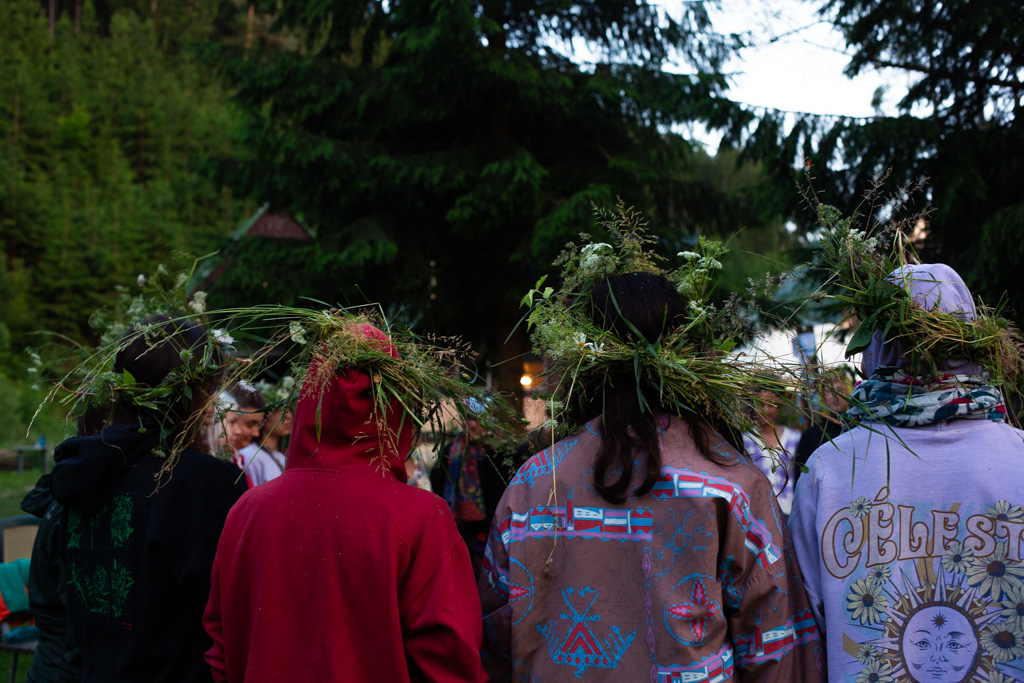
Hana: After years of observing academic institutions (such as HAMU), I’ve come to feel that there is still a strong belief that dance has a fixed, unchanging definition. It seems that many of the transformations that have taken place in dance over the past forty years are often dismissed as fleeting trends, rather than being acknowledged as legitimate developments within the field. As if there remains a belief that one day we will return to some kind of “real dance” — usually understood as constant movement, performance, technical virtuosity, and clearly legible form. And also, that what can be considered choreography has a clear and stable definition. Why do you think institutions have such a strong need to protect a certain historical canon, instead of openly recognizing that dance is in constant flux — and that what is today labelled as a fashion or trend may actually reflect a profound cultural and ontological shift in our relationship to the body, movement, and society?
Nora: But we’re just made of fashions, right?
Chloe: We did a residency recently in rural Vermont, called Black Hole Hollow, and the person who organizes this residency is Nicole Daunic. Her research with Hillary Clark is all about decentralizing the choreographer within. Taking the choreographer and putting the choreographer outside of the process even if the choreographer is an internalized sensation. Organizer composing the space, removing that from the self and letting the dance make itself, which reminds me of what we’re talking about. Of the dance becoming in charge of itself and knowing itself and maybe unknowing itself instead of an all-knowing figure, a figure that is composing and deciding and dictating what the dance needs to be and structuring it in this way. And when I hear modernism, what I hear is formalism or something. I notice that in New York, there are the formalists and then there are the experimentalists. I don’t know… in our small community of contemporary dance there’s people who are interested in doing these meaning-making, arranging, compositional dance pieces and then there’s people who are more interested in being in this more performative trance state, like working with states and doing research in that way of asking a question of the body and arriving at task or state or…
Hana: And you said it’s a minority?
Chloe: I don’t think it’s a minority. But I do think there’s a division between them, and of course there’s overlaps and things touch each other,
Hana: Like in the 60s downtown and uptown?
Chloe and Nora: Sure. Something that but …
Nora: But they’re all downtown now.
Chloe: They’re all downtown and I would still say…
Nora: I would say as for our community we’re talking about the downtown.
Chloe: But it is an interesting question of what the distinction is and where my interest lies. I feel so much more interested in this abstract not knowing practice. And I think I could imagine why that trend was happening. I think there’s something there about the feeling of apocalypse. Or the feeling of a lot of rising devastation. And an overwhelm and a deep uncertainty about what’s to come.
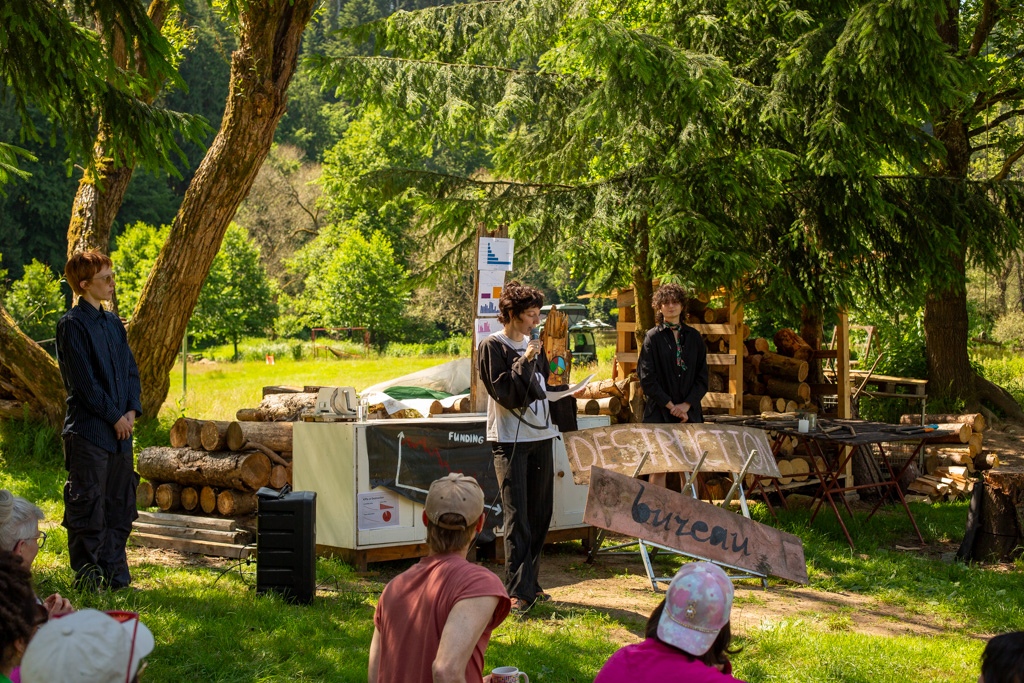
Hana: What’s to come in dance or globally in the world?
Chloe: Globally. And I think it’s reflected in dance, and I wonder too… it’s like a lot of these practices have a deep spirituality to them. I think there’s a return, even if it never left, but I feel like in this trend way that we’re talking about, I think there’s a leaning towards a spiritual understanding, which also is unknowing. And I wonder if that’s related to being in really deep global uncertainty.
Nora: If we want to, I can go to Andre Lepecki’s place. He’s one of my teachers and he has said this, but others have said this too: if we think about choreography in its history as the writing of dance and the attempt to capture movement and the attempt to command movement, I think there’s definitely a reaction to that. If we start to reckon with the truth of that, of choreography as a command, even if only sometimes, I think we can see why there’s a move to want to overthrow or want to mess with these power dynamics of choreographer and dancer and someone who commands and someone who obeys and that maybe that’s why the line between choreographer and dancer blurs, that’s why people are taking the choreographer out. Again, I would argue that resistance has always been happening but maybe in different ways. And maybe the way that it’s happening now is this embrace or need to be with uncertainty. And maybe also, (even if, again, it’s always been happening), now there is a more explicit need or desire to not separate the world from the dance.
Instead of insisting, this is just art. Perhaps people are increasingly saying: this is also life, this is also the world, and we can’t pretend that there’s a way to strip away the world from what we’re doing, what we’re dancing. And that also means politics is more acknowledged in every dance that’s created.
Hana: Recently, I shared several quotes from the professor and dance critic you study with, Nora — André Lepecki. These were the quotes that take a stance against neoliberalism and develop his concept of “exhausting dance,” as described in his book of the same name. One dance critic responded with a rather sharp question: “And what exactly is Mr. Lepecki’s proposed alternative?” That reaction struck me — not only because of its defensiveness, but also because of how telling it is about our context. It’s as if, especially since the 1990s, there has been a prevailing sense here that there is no alternative to capitalism and neoliberal ideology – or even that no alternative is allowed to exist. In this way, critical thinking itself is disqualified – as if it were not enough to question the dominant system unless one simultaneously provides a complete blueprint for its replacement. Lepecki points out that dance can be a site of resistance precisely through its capacity to stop, to exhaust itself, to fail, to lose form – and thereby to disrupt the logic of constant production, efficiency, growth, and individualism.
Nora: We’re attached. I think there’s a lot of attachment … you get rewarded for being an individual. And I think if it’s working for you (and that depends a lot on your social position) then I think maybe it’s less appealing to tear it down. But I think everyone’s having a hard time with the system that insists that we are separate and where it seems like survival is only possible through certain modes of success, certain modes of isolation.
Chloe: To bring it into Dancetopia, I want to add that Nora and I had a special experience of volunteering and being with the artists from Monday until we had the actual Dancetopia gathering, nearly a week, where we got to be even more in process with the artists as they were working. And in relation to this question of: what is the alternative, or folding the world into the dance, or taking down the idea of the individual person… there’s probably a cleaner way to say this, but maybe the alternative is removing the hierarchies or scrambling the hierarchies, of performer and audience and choreographer and…
Nora: Volunteer.
Chloe: Volunteer and curator and all of these roles that reflect some form of capitalism within the dance-making process. It’s interesting. And I think a lot of these artists, what happened for them was this beautiful confusion between who is performing and who is practicing and who is making the dance, and what we are paying attention to. For example, in Ran’s piece, you were the performer, and she was the shadow, but also performing with you, but you were performing it and the land was performing you. And so, I think maybe the alternative is building practices that don’t rely so much on, or don’t reflect so much the structures of capitalist production values that declare: that’s the person who gets paid this much, this is the payment structure here…
Nora: This is the product.
Chloe: This is the product that we’re building, who has ownership of this product, is the product from person to person equal – like everyone should be leaving the theatre with the same experience. What is failure in that context? I also think this is a really interesting question for Dancetopia. When you’re in the process and practicing and you’re bringing people into this unpredictability, you are encountering failure. We witnessed the artists folding that into the actual performance practice rather than trying to put a curtain around all badness, or anything that is considered not smooth or not pretty.
Nora: Right. Which I appreciated. I think, Hana, you sent an email after the fire talk, talking about happiness and the place of grief and frustration and anger in this work. And, even in a utopia, I do think the experience of all those things are still bleeding into and part of the work. Many of these artists and all of us are attempting to build alternatives or attempting to relate to land in ways that we weren’t taught to. And, I’m thinking about Bea who was talking a lot about not wanting the “nature” to be the backdrop, or to be the stage, and wanting to really…
Chloe: Or nature to be something she used.
Nora: Yeah, she didn’t want to “use” it. But that was a hard task because many of us have been trained to interact with “nature” that way. And I’m putting quotes around nature because we are nature, we are animals, that separation of human and nature is also constructed. But the training that we have is deep. And I was feeling that training too. I was noticing the abundance of Dancetopia and ideas and practices and people that I wanted to spend time with and feeling my own tendency towards extractivism. I wanted to write everything down, and talk to everyone, and really pull as much information as possible out of it. And then I was noticing, no, abundance actually means you can’t have it all and you can’t capture it all and it also includes a letting go. And that was my own personal struggle throughout. But there’s a lot of… I don’t want to call it instinct because I think it’s not instinct. There’s a deep social training towards extracting, towards scarcity.
Chloe: Yes, I’m interested in that too, or how to shift the paradigms around the way that we interact with art that then reflects our cultural upbringings. And we have to consider this at every level. I think competition, too, is another scarcity response. It tells us, there’s not enough for everybody, so we have to, I have to – if I want a certain kind of life or experience, I have to fight for it. It’s interesting to note that at Dancetopia I was also really thinking about certain patterns of thought that reflected this more capitalistic way of behaving socially. Which is an orientation towards use, extracting, and competing. They are subtle things that are happening. But it’s felt.
Nora: And that’s maybe what I appreciated too about what you said Hana: we can’t eliminate those things, actually, or we can’t pretend they’re not there for a weekend or try to purify ourselves of them. But how do we acknowledge them, accept them, and, I don’t know, let go? I am kind of the mind that I don’t think it’s possible to actually purify yourself of that.
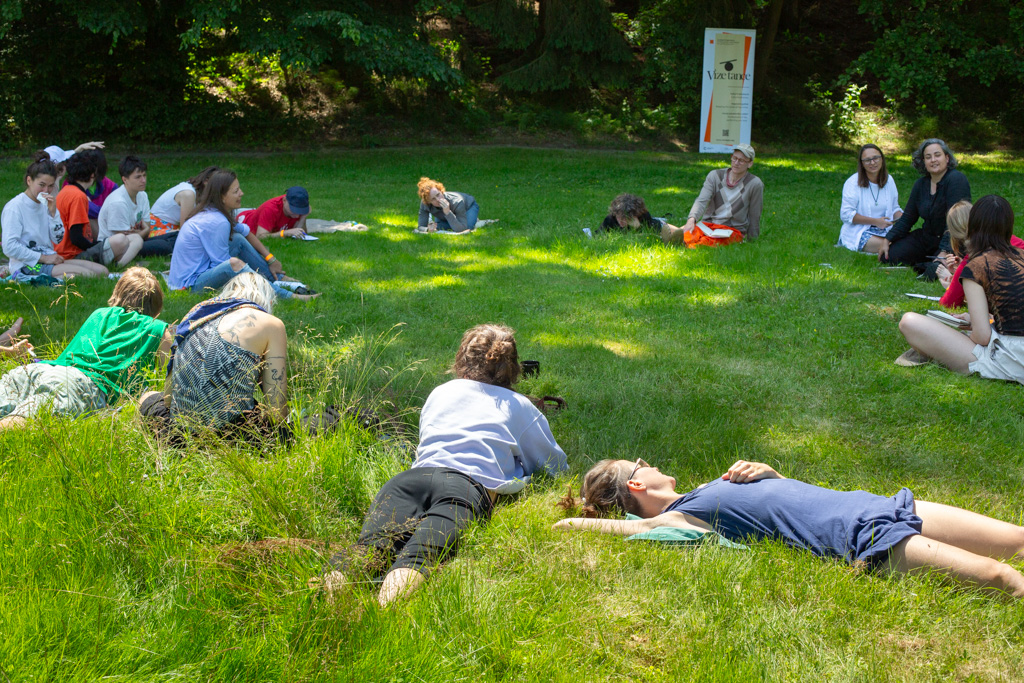
Hana: I think it could also be dangerous – trying to purify ourselves from what’s here can start to look like a kind of sect.
Nora: Yeah, it generates more separation too.
Hana: It makes no sense. I think we have to be aware of what’s going on. And then we can make small changes right within the system.
Nora: Small experiments.
Chloe: Also, I’m so conscious of the behaviours that are in response to certain behaviours. For example, if I feel scarcity in myself, or I feel competitive, and then I villainize those things, then I am creating a circular response. It’s a punishment, it’s carceral thinking to try to punish yourself into ridding yourself of these things, to try to rid myself of Elon Musk… I’m saying Elon Musk is a mythical sort of figure, a way of thinking that is solidified into a person. But we did this project, and I don’t know, is it OK to share, Nora?
Chloe: So, we were doing this project when we were at this residency where we were embodying two different roles, or many different roles, of characters that we know in the world that are real people but trying to dip into their consciousness. One of the roles was Elon Musk and the other one was this Buddhist teacher Tara Brach who has a podcast and gives a lot of dharma talks. And the game was to embody them and then write at these as these two different characters talking to each other, to maybe actually show how similar they are, or to reveal their similarities to each other more, noticing their attempts to fix and rid – these are two different responses to the same problem, for instance. Why does anyone do anything? What is our motivation behind what we’re doing? And how do we cope with being alive in the world? They have two different responses but then putting them on top of each other through their conversation with each other, we found there’s actually much more between them than we thought. Which feels related to this thing of saying, OK, my capitalistic persona, I have to rid myself of it. And I’m curious about what it’s also like to say to that persona, “OK, we’re gonna be with you here, with us, and I’m with you.” To not other a self that is existing within us.
Nora: Right, and in that writing exercise where we were these two characters (and then sometimes Fred Moten would pop in, because I also work with him, and feel I have his teachings echoing in my head often), a recurring theme was derived from Tara Brach’s talk about practicing saying “We are friends” to everyone. And so, over and over again, Tara was saying to Elon: “We are friends, we are friends, we are friends.” And during the residency, it also became something that we were saying often to each other, “We are friends.” And we would say it, too, whenever we felt resistance or anger. To yell “We are friends!” – what is that?
Chloe: It’s interesting in these places, in a kind of utopic setting, it’s very easy to slip into a way of thinking that claims “The bad guys are over there. We’re the ones who are doing it right. Here we are, we’re talking about all the right things, we’re doing the right practices, we have this good politic that connects us.” And I feel resistance to that. I feel that these people are here too, and we are them. It’s a different othering, a different flavour of it.
Nora: We are friends.
Notes:

André Lepecki is a curator, theorist, and professor of Performance Studies at New York University. In his writings, he explores the political, philosophical, and aesthetic dimensions of contemporary dance and performance. He is the author of the influential book Exhausting Dance: Performance and the Politics of Movement (2006), where he addresses dance as a form of resistance against regimes of representation and control of movement. In Singularities: Dance in the Age of Performance (2016), he focuses on the notion of singularity in performance as an event that escapes reproducibility and archiving. As an editor, he contributed to the essay collections Of the Presence of the Body: Essays on Dance and Performance Theory (2004) and Dance (2013), where he connects theoretical reflection with bodily practice. Lepecki consistently challenges traditional understandings of the body, movement, and authorship, and considers dance a site where aesthetics, politics, and affective memory converge.
Fred Moten is a key figure in contemporary Black studies, performance theory, and poetics. His work blends philosophy and poetry. His book The Feel Trio is considered one of the most significant works in contemporary experimental literature and Black radical thought.
“Biohacked” refers to a person or body that has been deliberately optimized or modified through so-called biohacking — which can involve dietary changes, supplements, smart technologies (e.g., sleep tracking), or even more invasive methods to enhance physical and mental performance.
Eiko Otake is a Japanese artist based in New York, where she has lived and created for many years. She collaborates with both American and international institutions and often teaches at universities such as Wesleyan University and Barnard College / Columbia University.
Judson Dance Theater emerged in the 1960s in New York as a radical collective that fundamentally redefined what could be considered dance. The group emphasized everyday movement, improvisation, and collaboration, challenging traditional notions of technique and authorship, and laying the groundwork for postmodern dance.
See: Sally Banes, Terpsichore in Sneakers (1987).
Nacera Belaza is an internationally acclaimed French-Algerian choreographer known for her minimalist and introspective approach to movement. Her work has been presented at many prestigious festivals and has received numerous awards, including the title of Chevalier de l’Ordre des Arts et des Lettres in France.
The “downtown” vs. “uptown” distinction in the 1960s and 70s New York dance scene refers to both aesthetic and institutional differences: “uptown” represented established modern dance (e.g., Martha Graham, Juilliard School), while “downtown” described experimental, postmodern approaches emerging outside official structures — in alternative venues such as Judson Memorial Church.
Nicole Daunic practices dance at the intersection of performance studies and post-anthropocentric approaches. At Bennington College, she leads the project Another Audience, which investigates performativity in “more-than-human” contexts — including human, non-human, and inanimate agents and their mutual interactions. Her research focuses on indeterminacy and collective possibilities in choreography — aiming to disrupt dominant modes of perception and economies of attention in dance. She challenges traditional anthropocentric concepts of audience and performance, thus expanding the boundaries of the field toward ecology and technology.
Hilary Clark is an American dancer, choreographer, and educator active since 1998 and recipient of the NY Dance & Performance Award (2008) for radical approaches in performance. Her work focuses on the materiality of the body, vulnerability, endurance, and the body’s capacity to hold memory — she sees the body as “the fabric of memory,” where external perception meets internal projection. Alongside Nicole Daunic, she develops the project MA(T)TERing, which incorporates somatic methods, improvisation, and co-creation, questioning fixed roles of authorship in choreography.
Tara Brach is a renowned American psychologist, meditation teacher, and author who integrates Western psychology with Buddhist mindfulness practices. In her talks and books, she emphasizes compassion, radical acceptance, and spiritual healing. Her lectures are widely accessible via podcasts and Dharma talks.


